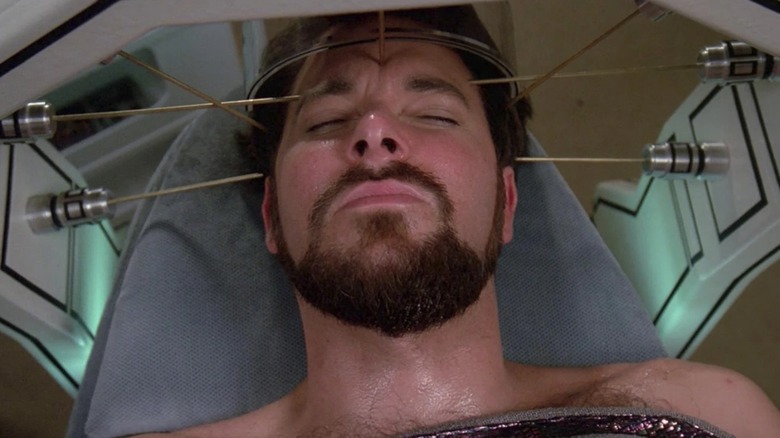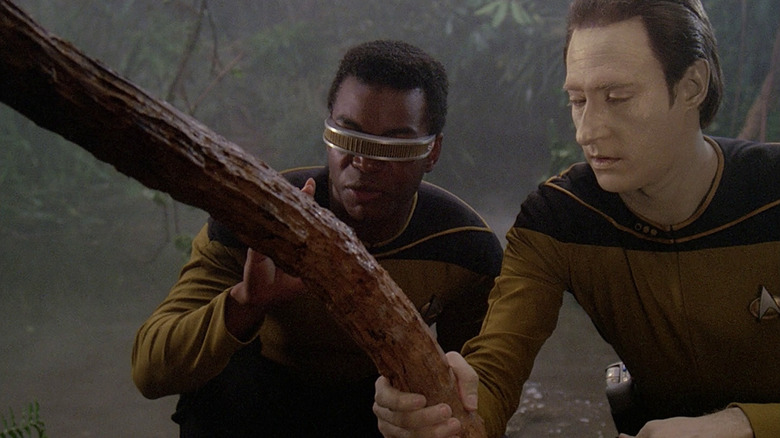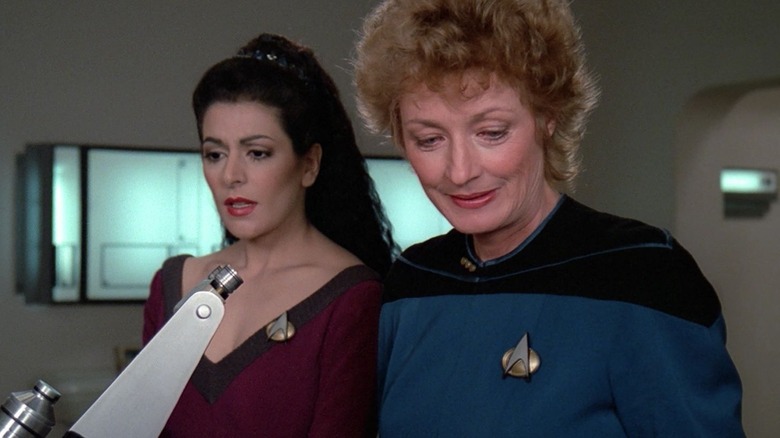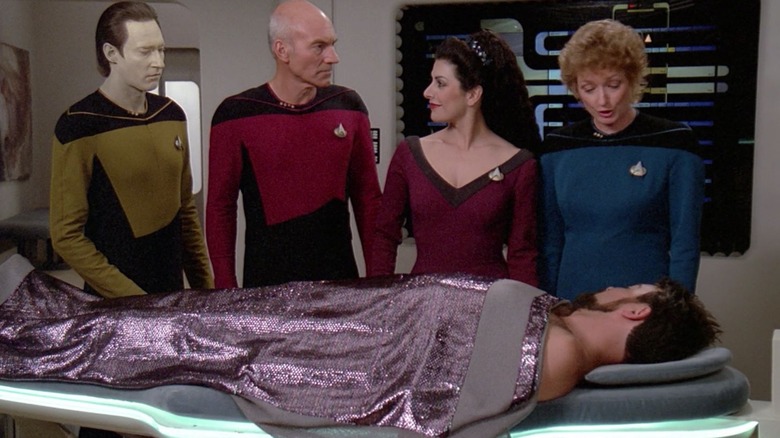How The 1988 Writers Strike Led To The Worst Episode Of Star Trek: The Next Generation
As all good Trekkies know, "Star Trek: The Next Generation" got off to a rocky start. As detailed in William Shatner's 2014 documentary "Chaos on the Bridge," "Next Generation" was hotly contested, with various producers and showrunners all vying for control over the project. There was a lot of animosity, as a result, and a lot of arguments as to what kind of scripts would be used. Show creator Gene Roddenberry, according to the film, was insistent that he had control over every facet of the production as he had been barred from working on the second, third, and fourth "Star Trek" movies, and wanted to make sure "his baby" was safe. There were, however, reports that Gene Roddenberry's personal lawyer, Leonard Maizlish, was taking completed scripts and re-writing them in secret. Executive Producer Rick Berman suspected that the written notes he received from Roddenberry were actually Maizlish's doing.
Maislish was gone by the start of season 2, but a 1988 writers strike stymied production, leaving the truncated season on uneasy footing as well. Most Trekkies will agree that "Next Generation" didn't hit its stride until its third season.
Most seasons of TV ran 26 episodes at the time. Season 2 ran only 22 episodes. Many of the scripts for season 2 were older screenplays that had been initially written for other Trek projects, some of them leftover from the original series. Thanks to new budgetary leeway, money could be more freely shifted around between episodes, which allowed for a few more ambitious ideas, like the debut of the Borg. Unluckily, this meant if one episode went over budget, another would have to be short-changed.
The strike, the chaos, and the lack of budget led to what is often considered the worst episode of "Star Trek: The Next Generation," "Shades of Grey."
The WGA Strike of 1988
Some brief history: the 1988 WGA strike was the longest strike in the organization's history, lasting 153 days. The strike was primarily inspired by producers refusing to pay writers residuals on the broadcast of reruns. Because reruns weren't performing well, producers tried to re-work contracts based on an unfair percentage model. Writers also wanted to give input on what kinds of actors and directors might be selected for their works and be assured higher budgets for specific projects.
Because producers refused to meet writers' demands, the strike ate into the "Next Generation" production schedule. The early episodes of the show's season were notably weird or bad. A few in the middle were actually quite excellent; "Measure of a Man" — about the nature of Data's sentience — and "Q Who" — the first Borg episode — are among the best of the series.
The season didn't start promisingly, though. The first episode of the second season of NextGen was called "The Child," and was about Counselor Deanna Troi (Marina Sirtis) being mysteriously impregnated by a non-corporeal alien of some kind. The child is born and grows to age 10 within the span of only a few weeks. This episode was initially written for the unmade 1970s "Star Trek" spinoff that was to be called "Star Trek: Phase II." That series was eventually transformed into "Star Trek: The Motion Picture," leaving a lot of the show's scripts on a pile on Roddenberry's desk. In desperate times, recycling was required.
Overall, season 2 was massively uneven. When it ran completely out of money, it ended with a whimper.
"Shades of Grey" was a clip show.
Shades of Grey
Even the premise for "Shades of Grey" (July 17, 1989) was thin. Commander Riker (Jonathan Frakes) was scratched by an alien thorn while on an away mission. The thorn contained a mysterious virus that attacked Ricker's brain, and he fell into a coma. In order to fight off the virus, Dr. Pulaski (Diana Muldaur) has to stimulate Riker's brain and force him to relive memories. In so doing, viewers were treated to flashbacks to previous episodes which took up about half of the show's running time. There were supposed to be themes of Riker's flashbacks — all his happy memories, all his scariest — but they didn't really fall together in a dramatically satisfying way.
In an age of on-demand streaming, it might be hard to see the function of clip shows other than as a cost-saving measure. The reader would do well to recall that 1988 TV shows needed to be seen on a set broadcast schedule and that many viewers would often miss individual episodes along the way. Additionally, it was impractical to put entire shows on VHS, and rerun schedules might prove unpredictable. So for many, primary broadcasts were the only way to see something. A clip show provided a series with a "sampler pack," giving neophytes a chance to preview older episodes that they might not have seen any other way.
But even at the time, clip shows were considered largely cheap. They were acknowledged as production stop-gaps until a better episode could be made. It felt especially cheap on "Star Trek" which had never done it before, and which was always good about presenting low-budget "bottle" episodes on the regular to avoid them. Watching the internal adventures of a comatose Riker provided no thrills.
More season 2 drama
The strike had ended by July of 1989, but its effects were still being felt. The new accounting also dealt its blow. "Elementary, Dear Data" was set mostly on the holodeck, and included period costumes and sets. "Q Who" features elaborate Borg makeup and Borg ship sets. Those two episodes, the rumor goes, drained "NextGen of its coffers, leaving "Shades of Grey" with nothing.
"Shades of Gray" was a slapdash affair. In Edward Gross' and Mark A. Altman's 1993 book "Captain's Logs: The Complete Trek Voyages," the episode's director, Rob Bowman, confessed that he had two fewer days to film the episode than most shows, leaving him and the crew on the sickbay set for only five days. At the last minute, however, the schedule was shortened to three days. If it looks like Sirtis and Muldaur are overacting, it's because they, too, were kind of in panic mode. Bowman said that he merely filmed the "wraparound" segments and that the flashback clips in question would be selected later by P.A. Eric Stillwell. Bowman said he never saw the final cut of the episode.
Also interviewed in "Voyages" was season two head writer Maurice Hurley, the producer responsible for firing Gates McFadden in the second season. Hurley, who wrote "Shades of Grey," understood that it was easily the most terrible episode they had done and called it a "piece of s***." Hurley was fired at the end of the season. McFadden was promptly re-hired.
Some might say that "Shades of Grey" isn't the worst episode of NextGen just because the first season episode "Code of Honor" banks on unfortunate racial stereotypes. And this is true.
But "Shades of Grey" might stand out as the least ambitious "Star Trek" ever. It's still terrible to this day.



